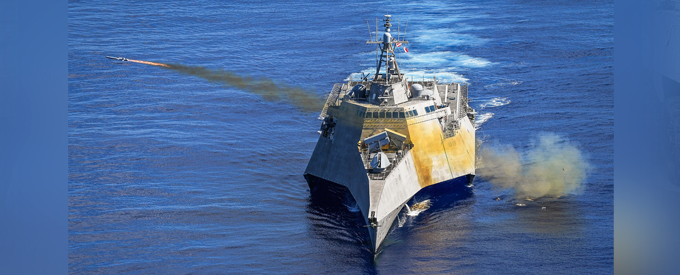2021-01-10
U.S. Missile Trio Proves its Mettle
When it comes to protecting U.S. Navy sailors and defending the fleet, Washington well knows that there can be absolutely no compromise.
This is where the powerful trio of advanced weapons — Raytheon Technologies’ Naval Strike Missile (NSM), Tomahawk cruise missile and SM-6 missile — steps in as a perfect shield.
While one missile skims the waves to avoid being seen, another can loiter for hours, shift course on command and strike a moving target with pinpoint accuracy. The third has the capacity to strike targets in the air and on the sea, including ballistic missiles.
NSM’s Reach
NSM is a long-range precision missile that possesses the ability to strike heavily defended land and sea targets. The missile, with a range of up to 100 nautical miles, flies at low altitudes and uses cutting-edge seeker and target-identification technology.
In 2018, the Navy selected the Naval Strike Missile for its over-the-horizon defence of littoral combat ships and future frigates. Raytheon Technologies has teamed with Norway’s Kongsberg to bring the fifth-generation missile stateside.
Randy Kempton, a programme director for Raytheon Missiles & Defense, a business of Raytheon Technologies, stated: “As we take these initial steps for domestic production, it’s clear the important role this missile will play for the U.S. Navy.”
The company is building the Naval Strike Missile’s U.S. supply chain, which will provide parts and create jobs for more than two dozen suppliers. The early stages of production are already underway. Missile launchers are set to be produced in Louisville, Kentucky.
Power of Tomahawk Block V
The U.S. Navy and Raytheon Missiles & Defense, a Raytheon Technologies business, has successfully completed two flight tests with the franchise’s newest cruise missile variant, the Tomahawk Block V.
During the tests in the last quarter of 2020 the USS Chafee (DDG 90) launched two Block V missiles, impacting targets at ranges on both San Nicolas Island and Naval Air Weapons Station China Lake in California.
The biggest advantage of Tomahawk is that it is a highly accurate, GPS-enabled missile that can fly into heavily defended airspace and conduct precise strikes on high-value targets with minimal collateral damage.
Tests have proved its efficiency. U.S. and allied militaries have flight-tested the GPS-enabled Tomahawk as many as 550 times and used it in combat more than 2,300 times. Its most recent use came in 2018, when U.S. Navy warships and submarines launched 66 Tomahawk missiles at Syrian chemical weapon facilities.
Kim Ernzen, vice president of Naval Power at Raytheon Missiles & Defense, said: “These tests keep the Navy on schedule to introduce Block V into the fleet next year. Our modernisation and recertification efforts will extend the missile’s service life by 15 years.”
Interestingly, during the tests, the missiles were redirected mid-flight to different targets using their new advanced communications architecture systems.
Capt. John Red, the Navy’s Tomahawk Weapons System programme manager, added: “The Block V capabilities reinforce Tomahawk’s unequivocal role as the Navy’s long-range strike weapon far into the future. These tests are tremendous milestones for our teams that have been working on these improvements for several years.”
The Tomahawk cruise missile can also launch from ships and submarines and can strike targets precisely from 1,000 miles, circle on command, transmit photos of a target to commanders and see through obscurants to hit a moving target at sea.
SM-6 Missile Capability
Protecting ships during war times is a big challenge. The SM-6 missile supports the Navy’s pursuit of sea control. Anti-air warfare, the missile’s original mission, enables the SM-6 to defend ships against enemy aircraft, unmanned aerial vehicles and even cruise missiles.
Anti-air warfare: SM-6 delivered on its initial mission to provide anti-air warfare support to the U.S. Navy by engaging manned and unmanned aircraft attacks and cruise missiles.
Ballistic missile defence: In 2015, the weapon protected ships against ballistic missiles in their final phase of flight, furthering the layers of defence.
Anti-surface warfare: The SM-6 missile hit its first surface target in 2016, making it the only missile to perform all three missions.
It has proved that it is the only weapon that can perform anti-air warfare, ballistic missile defence and anti-surface warfare missions. This supported the Navy’s concept of distributed lethality, or the ability to strike from any ship or location.
The SM-6 is deployable on 60 surface ships, and the company has supplied more than 500 missiles to the Navy.


No Comments